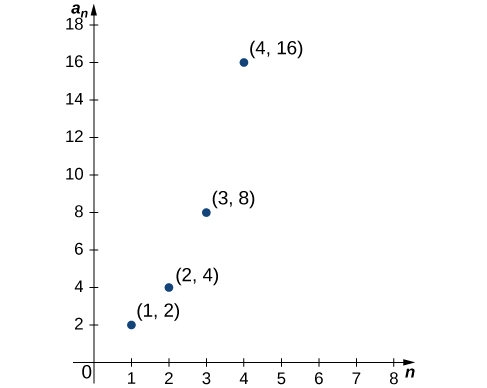
In this section, we introduce sequences and define what it means for a sequence to converge or diverge. We show how to find limits of sequences that converge, often by using the properties of limits for functions discussed earlier. We close this section with the Monotone Convergence Theorem, a tool we can use to prove that certain types of sequences converge.
To work with this new topic, we need some new terms and definitions. First, an infinite sequence is an ordered list of numbers of the form
Each of the numbers in the sequence is called a term. The symbol
is called the index variable for the sequence. We use the notation
to denote this sequence. A similar notation is used for sets, but a sequence is an ordered list, whereas a set is not ordered. Because a particular number
exists for each positive integer
we can also define a sequence as a function whose domain is the set of positive integers.
Let’s consider the infinite, ordered list
This is a sequence in which the first, second, and third terms are given by
and
You can probably see that the terms in this sequence have the following pattern:
Assuming this pattern continues, we can write the
term in the sequence by the explicit formula
Using this notation, we can write this sequence as
Alternatively, we can describe this sequence in a different way. Since each term is twice the previous term, this sequence can be defined recursively by expressing the
term
in terms of the previous term
In particular, we can define this sequence as the sequence
where
and for all
each term
is defined by the recurrence relation
An infinite sequence
is an ordered list of numbers of the form
The subscript
is called the index variable of the sequence. Each number
is a term of the sequence. Sometimes sequences are defined by explicit formulas, in which case
for some function
defined over the positive integers. In other cases, sequences are defined by using a recurrence relation. In a recurrence relation, one term (or more) of the sequence is given explicitly, and subsequent terms are defined in terms of earlier terms in the sequence.
Note that the index does not have to start at
but could start with other integers. For example, a sequence given by the explicit formula
could start at
in which case the sequence would be
Similarly, for a sequence defined by a recurrence relation, the term
may be given explicitly, and the terms
for
may be defined in terms of
Since a sequence
has exactly one value for each positive integer
it can be described as a function whose domain is the set of positive integers. As a result, it makes sense to discuss the graph of a sequence. The graph of a sequence
consists of all points
for all positive integers
[link] shows the graph of

Two types of sequences occur often and are given special names: arithmetic sequences and geometric sequences. In an arithmetic sequence, the difference between every pair of consecutive terms is the same. For example, consider the sequence
You can see that the difference between every consecutive pair of terms is
Assuming that this pattern continues, this sequence is an arithmetic sequence. It can be described by using the recurrence relation
Note that
Thus the sequence can also be described using the explicit formula
In general, an arithmetic sequence is any sequence of the form
In a geometric sequence, the ratio of every pair of consecutive terms is the same. For example, consider the sequence
We see that the ratio of any term to the preceding term is
Assuming this pattern continues, this sequence is a geometric sequence. It can be defined recursively as
Alternatively, since
we see that the sequence can be described by using the explicit formula
The sequence
that we discussed earlier is a geometric sequence, where the ratio of any term to the previous term is
In general, a geometric sequence is any sequence of the form
For each of the following sequences, find an explicit formula for the
term of the sequence.
term includes a factor of
Next, consider the sequence of numerators
and the sequence of denominators
We can see that both of these sequences are arithmetic sequences. The
term in the sequence of numerators is
and the
term in the sequence of denominators is
Therefore, the sequence can be described by the explicit formula
is a geometric sequence. The numerator of the
term is
The sequence of denominators
is an arithmetic sequence. The denominator of the
term is
Therefore, we can describe the sequence by the explicit formula
Find an explicit formula for the
term of the sequence
The denominators form an arithmetic sequence.
For each of the following recursively defined sequences, find an explicit formula for the sequence.
for
for
In general,
From this pattern, we derive the explicit formula
Find an explicit formula for the sequence defined recursively such that
and
This is an arithmetic sequence.
A fundamental question that arises regarding infinite sequences is the behavior of the terms as
gets larger. Since a sequence is a function defined on the positive integers, it makes sense to discuss the limit of the terms as
For example, consider the following four sequences and their different behaviors as
(see [link]):
The terms
become arbitrarily large as
In this case, we say that
as
The terms
as
The terms alternate but do not approach one single value as
The terms alternate for this sequence as well, but
as
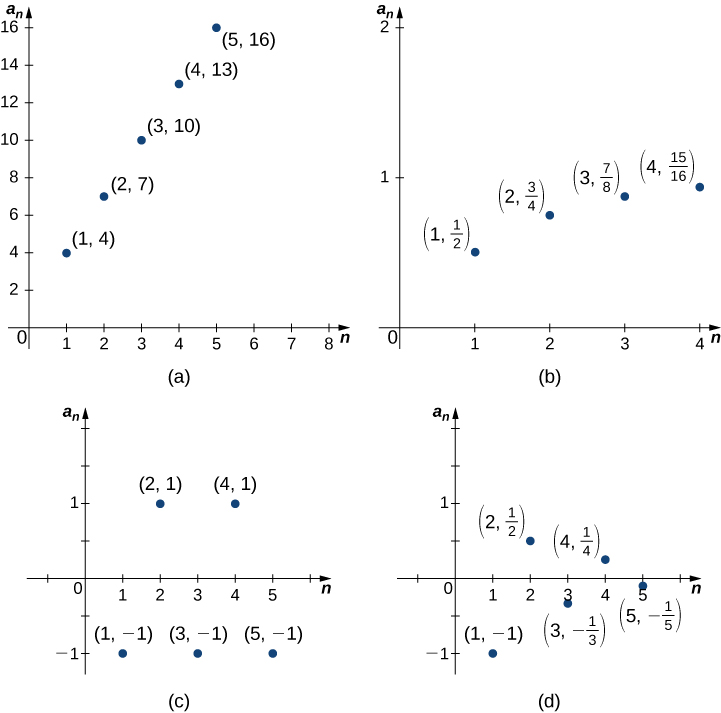
From these examples, we see several possibilities for the behavior of the terms of a sequence as
In two of the sequences, the terms approach a finite number as
In the other two sequences, the terms do not. If the terms of a sequence approach a finite number
as
we say that the sequence is a convergent sequence and the real number
is the limit of the sequence. We can give an informal definition here.
Given a sequence
if the terms
become arbitrarily close to a finite number
as
becomes sufficiently large, we say
is a convergent sequence and
is the limit of the sequence. In this case, we write
If a sequence
is not convergent, we say it is a divergent sequence.
From [link], we see that the terms in the sequence
are becoming arbitrarily close to
as
becomes very large. We conclude that
is a convergent sequence and its limit is
In contrast, from [link], we see that the terms in the sequence
are not approaching a finite number as
becomes larger. We say that
is a divergent sequence.
In the informal definition for the limit of a sequence, we used the terms “arbitrarily close” and “sufficiently large.” Although these phrases help illustrate the meaning of a converging sequence, they are somewhat vague. To be more precise, we now present the more formal definition of limit for a sequence and show these ideas graphically in [link].
A sequence
converges to a real number
if for all
there exists an integer
such that
if
The number
is the limit of the sequence and we write
In this case, we say the sequence
is a convergent sequence. If a sequence does not converge, it is a divergent sequence, and we say the limit does not exist.
We remark that the convergence or divergence of a sequence
depends only on what happens to the terms
as
Therefore, if a finite number of terms
are placed before
to create a new sequence
this new sequence will converge if
converges and diverge if
diverges. Further, if the sequence
converges to
this new sequence will also converge to
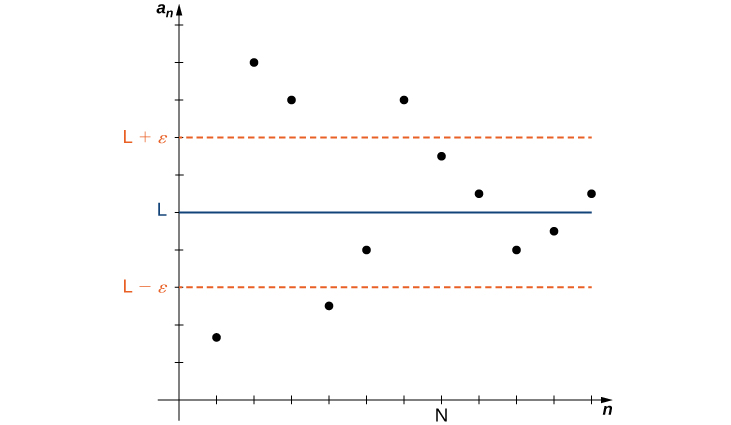
As defined above, if a sequence does not converge, it is said to be a divergent sequence. For example, the sequences
and
shown in [link] diverge. However, different sequences can diverge in different ways. The sequence
diverges because the terms alternate between
and
but do not approach one value as
On the other hand, the sequence
diverges because the terms
as
We say the sequence
diverges to infinity and write
It is important to recognize that this notation does not imply the limit of the sequence
exists. The sequence is, in fact, divergent. Writing that the limit is infinity is intended only to provide more information about why the sequence is divergent. A sequence can also diverge to negative infinity. For example, the sequence
diverges to negative infinity because
as
We write this as
Because a sequence is a function whose domain is the set of positive integers, we can use properties of limits of functions to determine whether a sequence converges. For example, consider a sequence
and a related function
defined on all positive real numbers such that
for all integers
Since the domain of the sequence is a subset of the domain of
if
exists, then the sequence converges and has the same limit. For example, consider the sequence
and the related function
Since the function
defined on all real numbers
satisfies
as
the sequence
must satisfy
as
Consider a sequence
such that
for all
If there exists a real number
such that
then
converges and
We can use this theorem to evaluate
for
For example, consider the sequence
and the related exponential function
Since
we conclude that the sequence
converges and its limit is
Similarly, for any real number
such that
and therefore the sequence
converges. On the other hand, if
then
and therefore the limit of the sequence
is
If
and therefore we cannot apply this theorem. However, in this case, just as the function
grows without bound as
the terms
in the sequence become arbitrarily large as
and we conclude that the sequence
diverges to infinity if
We summarize these results regarding the geometric sequence
Later in this section we consider the case when
We now consider slightly more complicated sequences. For example, consider the sequence
The terms in this sequence are more complicated than other sequences we have discussed, but luckily the limit of this sequence is determined by the limits of the two sequences
and
As we describe in the following algebraic limit laws, since
and
both converge to
the sequence
converges to
Just as we were able to evaluate a limit involving an algebraic combination of functions
and
by looking at the limits of
and
(see Introduction to Limits), we are able to evaluate the limit of a sequence whose terms are algebraic combinations of
and
by evaluating the limits of
and
Given sequences
and
and any real number
if there exist constants
and
such that
and
then
provided
and each
We prove part iii.
Let
Since
there exists a constant positive integer
such that for all
Since
there exists a constant
such that
for all
Let
be the largest of
and
Therefore, for all
□
The algebraic limit laws allow us to evaluate limits for many sequences. For example, consider the sequence
As shown earlier,
Similarly, for any positive integer
we can conclude that
In the next example, we make use of this fact along with the limit laws to evaluate limits for other sequences.
For each of the following sequences, determine whether or not the sequence converges. If it converges, find its limit.
Using this fact, we conclude that
Therefore,
The sequence converges and its limit is
out of the numerator and denominator and using the limit laws above, we have
The sequence converges and its limit is
defined on all real numbers
Since
and
as
apply L’Hôpital’s rule and write
We conclude that the sequence diverges.
defined on all real numbers
This function has the indeterminate form
as
Let
Now taking the natural logarithm of both sides of the equation, we obtain
Since the function
is continuous on its domain, we can interchange the limit and the natural logarithm. Therefore,
Using properties of logarithms, we write
Since the right-hand side of this equation has the indeterminate form
rewrite it as a fraction to apply L’Hôpital’s rule. Write
Since the right-hand side is now in the indeterminate form
we are able to apply L’Hôpital’s rule. We conclude that
Therefore,
and
Therefore, since
we can conclude that the sequence
converges to
Consider the sequence
Determine whether or not the sequence converges. If it converges, find its limit.
The sequence converges, and its limit is
Use L’Hôpital’s rule.
Recall that if
is a continuous function at a value
then
as
This idea applies to sequences as well. Suppose a sequence
and a function
is continuous at
Then
This property often enables us to find limits for complicated sequences. For example, consider the sequence
From [link]a. we know the sequence
Since
is a continuous function at
Consider a sequence
and suppose there exists a real number
such that the sequence
converges to
Suppose
is a continuous function at
Then there exists an integer
such that
is defined at all values
for
and the sequence
converges to
([link]).
Let
Since
is continuous at
there exists
such that
if
Since the sequence
converges to
there exists
such that
for all
Therefore, for all
which implies
We conclude that the sequence
converges to
□
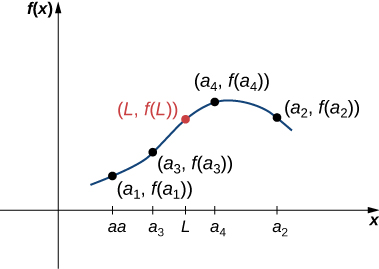
Determine whether the sequence
converges. If it converges, find its limit.
Since the sequence
converges to
and
is continuous at
we can conclude that the sequence
converges and
Determine if the sequence
converges. If it converges, find its limit.
The sequence converges, and its limit is
Consider the sequence
Another theorem involving limits of sequences is an extension of the Squeeze Theorem for limits discussed in Introduction to Limits.
Consider sequences
and
Suppose there exists an integer
such that
If there exists a real number
such that
then
converges and
([link]).
Let
Since the sequence
converges to
there exists an integer
such that
for all
Similarly, since
converges to
there exists an integer
such that
for all
By assumption, there exists an integer
such that
for all
Let
be the largest of
and
We must show that
for all
For all
Therefore,
and we conclude that
for all
and we conclude that the sequence
converges to
□
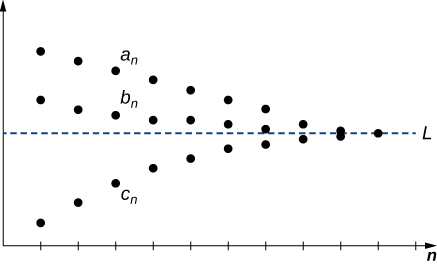
Use the Squeeze Theorem to find the limit of each of the following sequences.
for all integers
we have
Since
and
we conclude that
as well.
for all positive integers
and
we can conclude that
Find
Use the fact that
Using the idea from [link]b. we conclude that
for any real number
such that
If
the sequence
diverges because the terms oscillate and become arbitrarily large in magnitude. If
the sequence
diverges, as discussed earlier. Here is a summary of the properties for geometric sequences.
We now turn our attention to one of the most important theorems involving sequences: the Monotone Convergence Theorem. Before stating the theorem, we need to introduce some terminology and motivation. We begin by defining what it means for a sequence to be bounded.
A sequence
is bounded above if there exists a real number
such that
for all positive integers
A sequence
is bounded below if there exists a real number
such that
for all positive integers
A sequence
is a bounded sequence if it is bounded above and bounded below.
If a sequence is not bounded, it is an unbounded sequence.
For example, the sequence
is bounded above because
for all positive integers
It is also bounded below because
for all positive integers n. Therefore,
is a bounded sequence. On the other hand, consider the sequence
Because
for all
the sequence is bounded below. However, the sequence is not bounded above. Therefore,
is an unbounded sequence.
We now discuss the relationship between boundedness and convergence. Suppose a sequence
is unbounded. Then it is not bounded above, or not bounded below, or both. In either case, there are terms
that are arbitrarily large in magnitude as
gets larger. As a result, the sequence
cannot converge. Therefore, being bounded is a necessary condition for a sequence to converge.
If a sequence
converges, then it is bounded.
Note that a sequence being bounded is not a sufficient condition for a sequence to converge. For example, the sequence
is bounded, but the sequence diverges because the sequence oscillates between
and
and never approaches a finite number. We now discuss a sufficient (but not necessary) condition for a bounded sequence to converge.
Consider a bounded sequence
Suppose the sequence
is increasing. That is,
Since the sequence is increasing, the terms are not oscillating. Therefore, there are two possibilities. The sequence could diverge to infinity, or it could converge. However, since the sequence is bounded, it is bounded above and the sequence cannot diverge to infinity. We conclude that
converges. For example, consider the sequence
Since this sequence is increasing and bounded above, it converges. Next, consider the sequence
Even though the sequence is not increasing for all values of
we see that
Therefore, starting with the eighth term,
the sequence is increasing. In this case, we say the sequence is eventually increasing. Since the sequence is bounded above, it converges. It is also true that if a sequence is decreasing (or eventually decreasing) and bounded below, it also converges.
A sequence
is increasing for all
if
A sequence
is decreasing for all
if
A sequence
is a monotone sequence for all
if it is increasing for all
or decreasing for all
We now have the necessary definitions to state the Monotone Convergence Theorem, which gives a sufficient condition for convergence of a sequence.
If
is a bounded sequence and there exists a positive integer
such that
is monotone for all
then
converges.
The proof of this theorem is beyond the scope of this text. Instead, we provide a graph to show intuitively why this theorem makes sense ([link]).
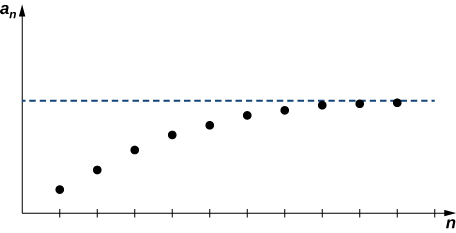
In the following example, we show how the Monotone Convergence Theorem can be used to prove convergence of a sequence.
For each of the following sequences, use the Monotone Convergence Theorem to show the sequence converges and find its limit.
defined recursively such that
At first, the terms increase. However, after the third term, the terms decrease. In fact, the terms decrease for all
We can show this as follows.
Therefore, the sequence is decreasing for all
Further, the sequence is bounded below by
because
for all positive integers
Therefore, by the Monotone Convergence Theorem, the sequence converges.
To find the limit, we use the fact that the sequence converges and let
Now note this important observation. Consider
Since
the only difference between the sequences
and
is that
omits the first term. Since a finite number of terms does not affect the convergence of a sequence,
Combining this fact with the equation
and taking the limit of both sides of the equation
we can conclude that
we can conjecture that the sequence is decreasing and bounded below by
To show that the sequence is bounded below by
we can show that
To show this, first rewrite
Since
and
is defined as a sum of positive terms,
Similarly, all terms
Therefore,
if and only if
Rewriting the inequality
as
and using the fact that
because the square of any real number is nonnegative, we can conclude that
To show that the sequence is decreasing, we must show that
for all
Since
it follows that
Dividing both sides by
we obtain
Using the definition of
we conclude that
Since
is bounded below and decreasing, by the Monotone Convergence Theorem, it converges.
To find the limit, let
Then using the recurrence relation and the fact that
we have
and therefore
Multiplying both sides of this equation by
we arrive at the equation
Solving this equation for
we conclude that
which implies
Since all the terms are positive, the limit
Consider the sequence
defined recursively such that
Use the Monotone Convergence Theorem to show that this sequence converges and find its limit.
Show the sequence is decreasing and bounded below.
The Fibonacci numbers are defined recursively by the sequence
where
and for
Here we look at properties of the Fibonacci numbers.
where
and
Show that this sequence can be described by the closed formula
for all
of the form
Determine what two values for
will allow
to satisfy this equation.
and
Let
Use the initial conditions
and
to determine the values for the constants
and
and write the closed formula
The number
is known as the golden ratio ([link] and [link]).

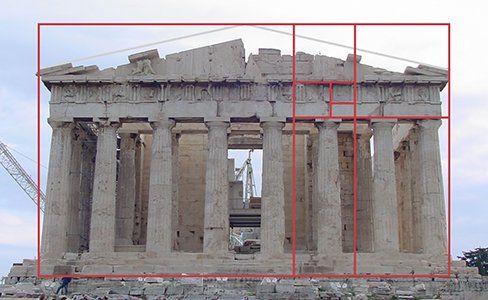
we use the properties of limits for functions.
and
are convergent sequences that converge to
and
respectively, and
is any real number, then the sequence
converges to
the sequences
converge to
the sequence
converges to
and the sequence
converges to
provided
converges if and only if
or
Find the first six terms of each of the following sequences, starting with
for
if
is odd and
if
is even
for
and
for
and
for
Find an explicit formula for
where
and
for
Find a formula
for the
term of the arithmetic sequence whose first term is
such that
for
Find a formula
for the
term of the arithmetic sequence whose first term is
such that
for
Find a formula
for the
term of the geometric sequence whose first term is
such that
for
Find a formula
for the
term of the geometric sequence whose first term is
such that
for
Find an explicit formula for the
term of the sequence whose first several terms are
(Hint: First add one to each term.)
Find an explicit formula for the
term of the sequence satisfying
and
for
Find a formula for the general term
of each of the following sequences.
(Hint: Find where
takes these values)
Find a function
that identifies the
term
of the following recursively defined sequences, as
and
for
and
for
and
for
and
for
and
for
Plot the first
terms of each sequence. State whether the graphical evidence suggests that the sequence converges or diverges.
[T]
and for
Terms oscillate above and below
and appear to converge to
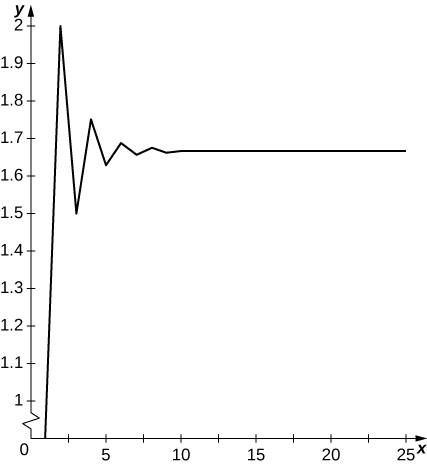
[T]
and for
[T]
and for
Terms oscillate above and below
and appear to converge to a limit.* * *
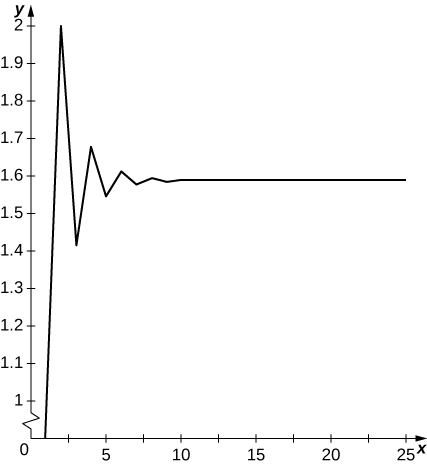
[T]
and for
Suppose that
and
for all
Evaluate each of the following limits, or state that the limit does not exist, or state that there is not enough information to determine whether the limit exists.
Find the limit of each of the following sequences, using L’Hôpital’s rule when appropriate.
(Hint:
For each of the following sequences, whose
terms are indicated, state whether the sequence is bounded and whether it is eventually monotone, increasing, or decreasing.
bounded, decreasing for
bounded, not monotone
bounded, decreasing
not monotone, not bounded
Determine whether the sequence defined as follows has a limit. If it does, find the limit.
etc.
Determine whether the sequence defined as follows has a limit. If it does, find the limit.
is decreasing and bounded below by
The limit
must satisfy
so
independent of the initial value.
Use the Squeeze Theorem to find the limit of each of the following sequences.
and
so
For the following sequences, plot the first
terms of the sequence and state whether the graphical evidence suggests that the sequence converges or diverges.
[T]
[T]
Graph oscillates and suggests no limit.* * *
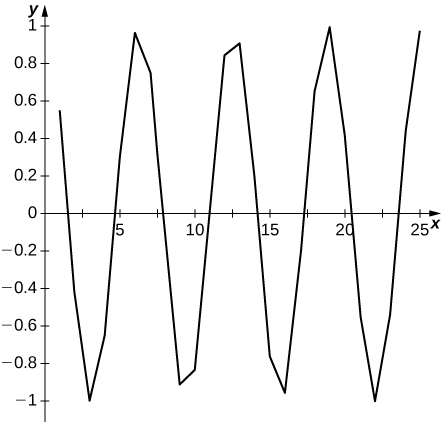
Determine the limit of the sequence or show that the sequence diverges. If it converges, find its limit.
and
so
Since
one has
as
and
as
so
as
In particular,
so
as
Newton’s method seeks to approximate a solution
that starts with an initial approximation
and successively defines a sequence
For the given choice of
and
write out the formula for
If the sequence appears to converge, give an exact formula for the solution
then identify the limit
accurate to four decimal places and the smallest
such that
agrees with
up to four decimal places.
[T]
[T]
[T]
[T]
[T] Suppose you start with one liter of vinegar and repeatedly remove
replace with water, mix, and repeat.
steps.
vinegar?
[T] A lake initially contains
fish. Suppose that in the absence of predators or other causes of removal, the fish population increases by
each month. However, factoring in all causes,
fish are lost each month.
months is modeled by
with
a. Without losses, the population would obey
The subtraction of
accounts for fish losses. b. After
months, we have
[T] A bank account earns
interest compounded monthly. Suppose that
is initially deposited into the account, but that
is withdrawn each month.
months is
year?
a fixed amount
dollars is withdrawn each month. Find a value of
such that the amount in the account after each month remains
is greater than this amount?
[T] A student takes out a college loan of
at an annual percentage rate of
compounded monthly.
per month, how much does the student owe after
months?
a. The student owes
after
months. b. The loan will be paid in full after
months or eleven and a half years.
[T] Consider a series combining geometric growth and arithmetic decrease. Let
Fix
and
Set
Find a formula for
in terms of
and
and a relationship between
and
such that
converges.
[T] The binary representation
of a number
between
and
can be defined as follows. Let
if
and
if
Let
Let
if
and
if
Let
and in general,
and
if
and
if
Find the binary expansion of
so the pattern repeats, and
[T] To find an approximation for
set
and, in general,
Finally, set
Find the first ten terms of
and compare the values to
For the following two exercises, assume that you have access to a computer program or Internet source that can generate a list of zeros and ones of any desired length. Pseudorandom number generators (PRNGs) play an important role in simulating random noise in physical systems by creating sequences of zeros and ones that appear like the result of flipping a coin repeatedly. One of the simplest types of PRNGs recursively defines a random-looking sequence of
integers
by fixing two special integers
and
and letting
be the remainder after dividing
into
then creates a bit sequence of zeros and ones whose
term
is equal to one if
is odd and equal to zero if
is even. If the bits
are pseudorandom, then the behavior of their average
should be similar to behavior of averages of truly randomly generated bits.
[T] Starting with
and
using ten different starting values of
compute sequences of bits
up to
and compare their averages to ten such sequences generated by a random bit generator.
For the starting values
the corresponding bit averages calculated by the method indicated are
and
Here is an example of ten corresponding averages of strings of
bits generated by a random number generator:
There is no real pattern in either type of average. The random-number-generated averages range between
and
a range of
whereas the calculated PRNG bit averages range between
and
a range of
[T] Find the first
digits of
using either a computer program or Internet resource. Create a bit sequence
by letting
if the
digit of
is odd and
if the
digit of
is even. Compute the average value of
and the average value of
Does the sequence
appear random? Do the differences between successive elements of
appear random?
is bounded above if there exists a constant
such that
for all positive integers
is bounded below if there exists a constant
such that
for all positive integers
is bounded if there exists a constant
such that
for all positive integers
for which there exists a real number
such that
is arbitrarily close to
as long as
is sufficiently large
in which the ratio
is the same for all positive integers
is called a geometric sequence
to which a sequence converges is called the limit of the sequence
in a sequence is defined in terms of earlier terms in the sequence
is a sequence
in the sequence
is called the
term of the sequence

You can also download for free at http://cnx.org/contents/9a1df55a-b167-4736-b5ad-15d996704270@5.1
Attribution: